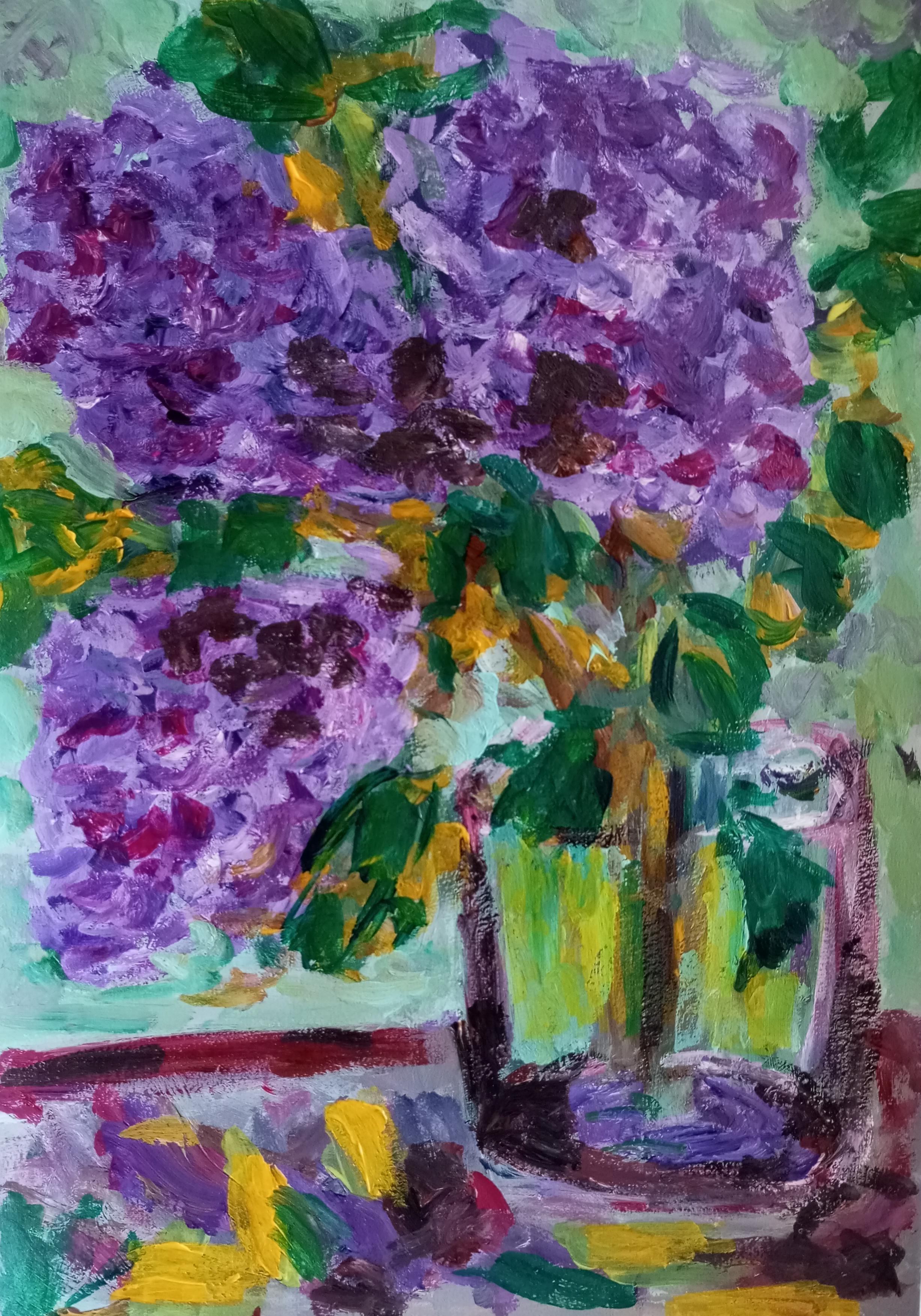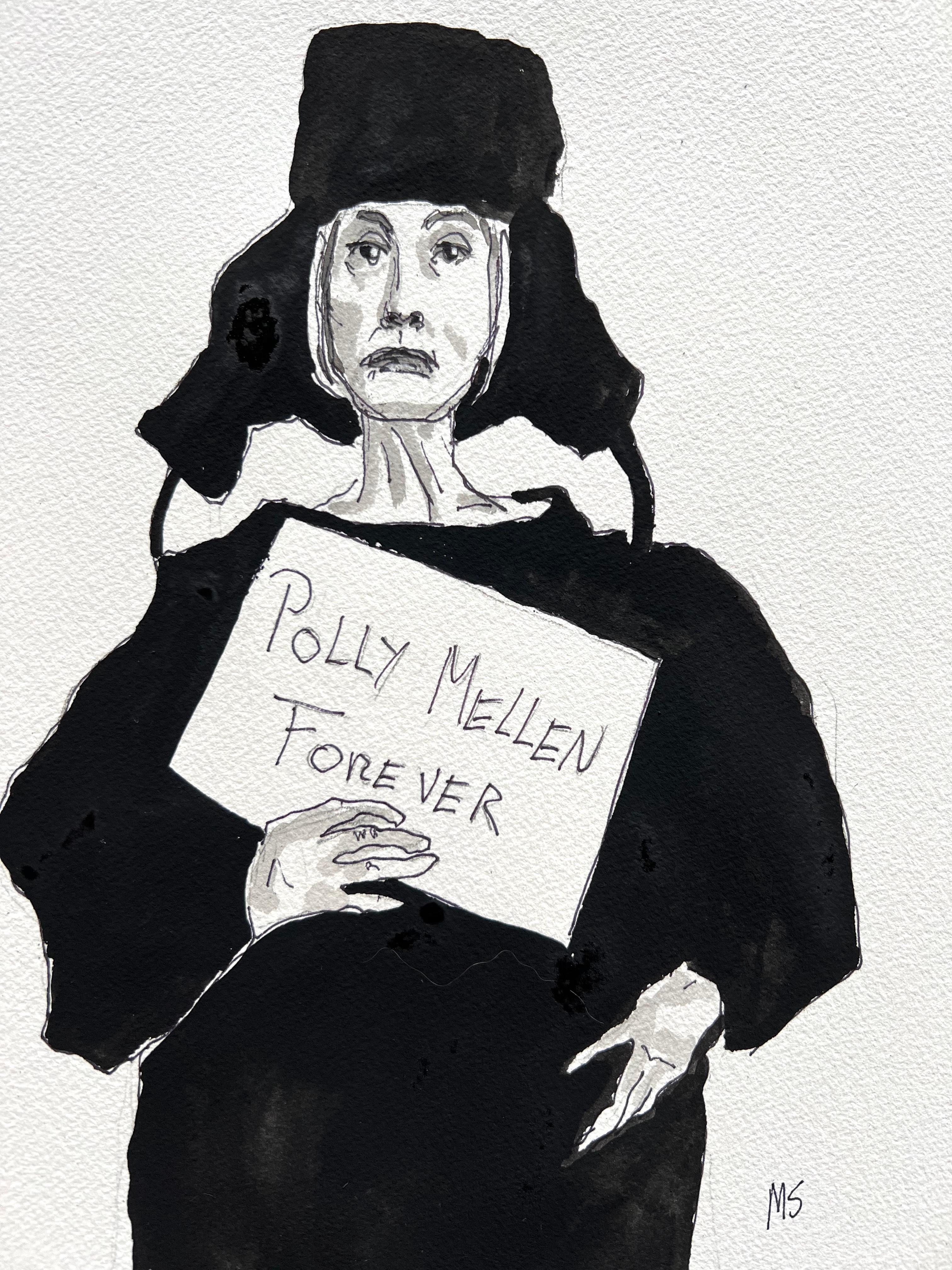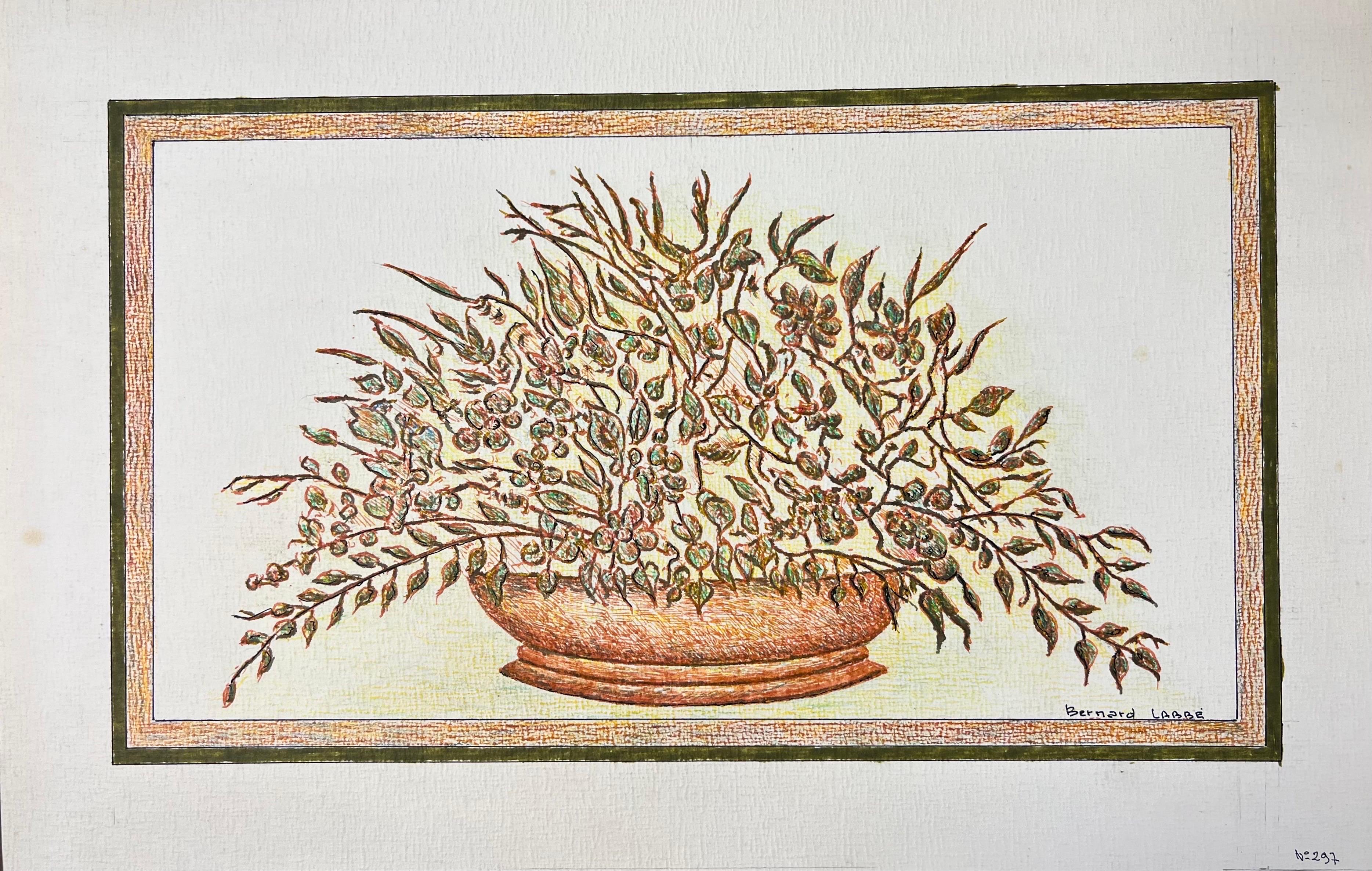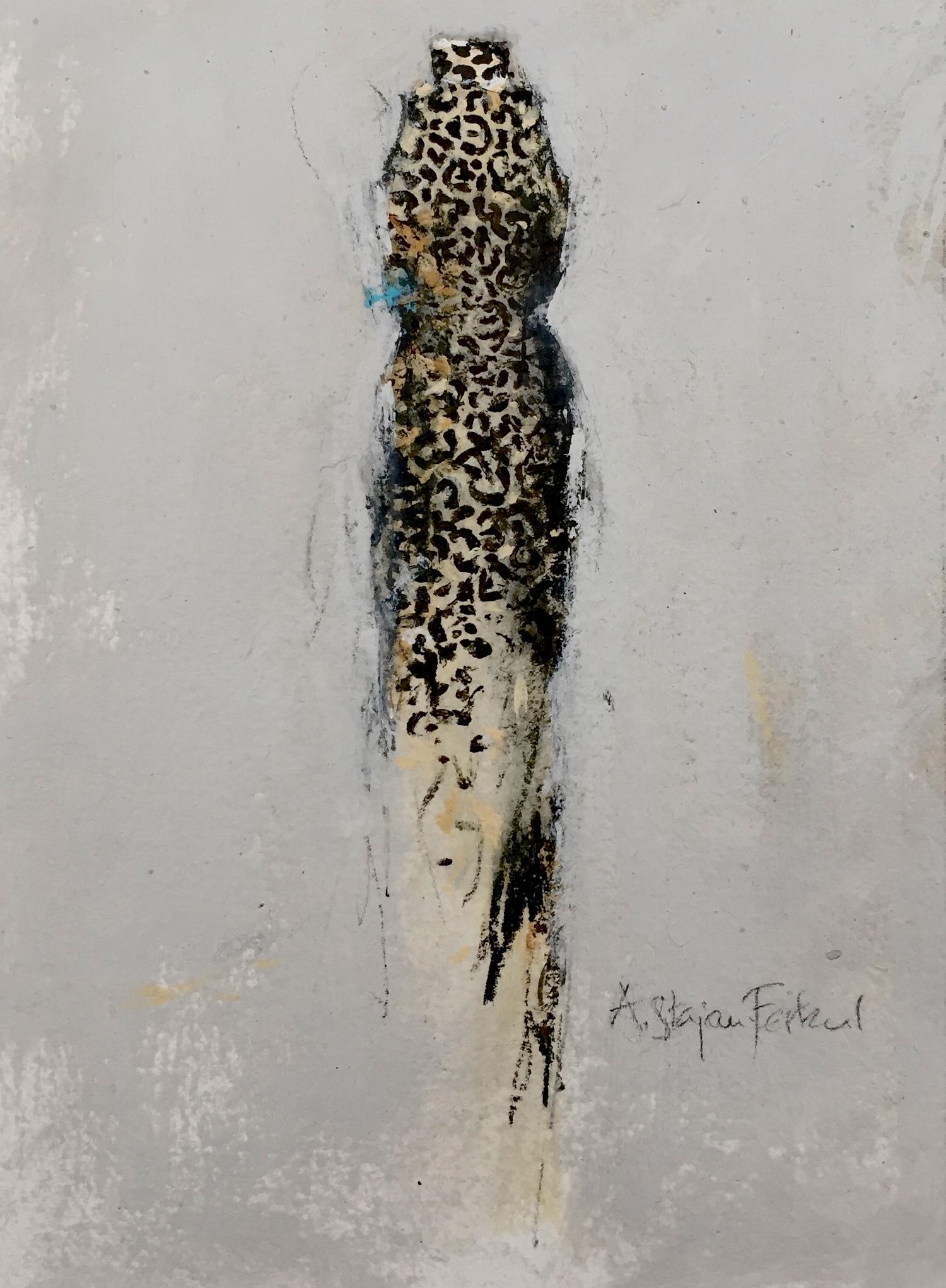Items Similar to Surrealist Painting on Paper, 'Godot', Artefacts of Civilisations Lost
Video Loading
Want more images or videos?
Request additional images or videos from the seller
1 of 24
Derek Carruthers Surrealist Painting on Paper, 'Godot', Artefacts of Civilisations Lost1985
1985
About the Item
A late 20th century watercolour, gouache and acrylic on paper by British artist Derek Carruthers. Signed to the bottom right and dated 1985 and titled, 'Godot' to the reverse.
A charming and slightly satirical painting of thousand year old figures which have been humanised. The Egyptian basalt figures are looking around the space clearly waiting for something or someone (hence the title taken from the play, 'Waiting for Godot' in which someone is expected to arrive but never does). The African tribal figures have fallen asleep in their boredom, the pyramid has shrunk to a minute size and one of the Chinese figures has even given up and fallen over whilst waiting. There is a sense of time ticking away and marching on whilst the figures wait and wait. The figures represent ancient dynasties, civilisations which have had their day. Their importance slumbering away in the annals of history. A reminder that our civilisation as much as we value it is no more important or immune to the passing of time. Perhaps these ancient civilisations are waiting to be awoken but as with 'Godot' this is never to come.
Derek Carruthers was an artist who persisted in asking questions. His whole career was inspired by the determination to enquire into the nature of art, examine its purpose, and attempt to explore that place where the individual life of the mind meets the external appearance of the world where personal sensation rubs up against cultural assumptions. Not surprisingly, Carruthers explored, over the years, a language of pure form, abstract space, 2 and 3 dimensions, narrative and concept, personal and universal figuration. Looking back, over decades of work, however, each of these voices is pursuing a coherent set of questions, reflecting on the stuff of human experience. Carrthuers’ individual pieces can intrigue and charm, they can be warm and poetic and they can also offer gritty resistance to the easy gaze. They can challenge us to think about ourselves, our environment, our expectations, our place in the world.
Carruthers grew up in the north-west of England having been born in Penrith, and one of his earliest memories of what art might be was formed by his encounter with the extraordinary creations of Kurt Schwitters. The latter had fled Germany in 1937, after his art had been labelled ‘degenerate’. He stayed, first, in Norway and then arrived in Britain in 1940. Carruthers had already encountered Schwitters' work as a boy, and had been launched on his own life-long examination of the nature of art.
Carruthers was further inspired by Victor Pasmore and Hamilton (British Constructivists) who were working closely together at King’s College London and eventually offered a challenging course to all first year students. Thus, Carruthers – who was at King’s in 1953 to 1957 was encouraged to take a rigorous approach to probing abstraction, spatial relationships, and the interlinking of art and architecture.
Having had the good fortune to have been an art student at such a time and in such a place, it is not surprising that Carruthers embarked on a voyage of artistic discovery. He showed his works with the major touring exhibition, organised by the Arts Council, in 1963, ‘Construction England’, together with Pasmore and Mary and Kenneth Martin.
His work was also included in exhibitions of new art at the Drian Galleries, Porchester Place, in 1963 to 1965. Reflecting the more recent re-examination of post-War, British Constructivism, Carruthers’ work was also included in the 1992 show, ‘British Abstract Art of the 50s and 60s’, held at the Belgrave Gallery. This early work, in which solid or relief forms change their nature as they – or the viewers – move through space and time, deliberately challenges the human tendency to find comfort in regarding the world as fixed and knowable.
In these years, too, Carruthers taught at Sunderland and Leicester Colleges of Art, before moving to lead the Fine Art course, as a Professor, at Trent Polytechnic (now the Nottingham Trent University). He was a dedicated educator, leaving to pursue his own art, full time, only in the mid 1980s.
Inspired, perhaps, by this freedom, the 1980s saw Carruthers exploring new ideas. He turned from working in 3-dimensions, or collage and relief, and rediscovered the power of traditional materials, oil and watercolour, on canvas and paper. He moved away from Non-Objectivity towards a practice which explored both abstracted and figurative imagery. Throughout, he remained preoccupied with exploring the human condition: by this trite remark, we mean that he continued to question how each individual experiences the world; he explored the ways in which human beings create totems to make their mark, as if to claim immortality; he tries to, ‘symbolise the triangular relationship between humankind and religion and the art / architecture which it inspires’. Hence - as well as warm glimpses of holidays and home life - his work yields the Egyptian pyramid, the Graeco-Roman heroic figure, the Christian monument; and, ultimately, the ‘sexless, ageless, raceless anonymity’ of the artist’s lay figure.
Derek Carruthers continued to ask questions, both about his life in a particular time and place, and about the lot of the human being on a universal scale. As an artist and a scholar, he saw himself at the intersection of these challenging states. And he makes you think........
- Creator:Derek Carruthers
- Creation Year:1985
- Dimensions:Height: 19.69 in (50 cm)Width: 27.56 in (70 cm)Depth: 0.08 in (2 mm)
- Medium:
- Movement & Style:
- Period:
- Condition:
- Gallery Location:Cotignac, FR
- Reference Number:
About the Seller
5.0
Platinum Seller
These expertly vetted sellers are 1stDibs' most experienced sellers and are rated highest by our customers.
Established in 2000
1stDibs seller since 2020
157 sales on 1stDibs
Typical response time: 1 hour
- ShippingRetrieving quote...Ships From: Cotignac, France
- Return PolicyA return for this item may be initiated within 3 days of delivery.
More From This SellerView All
- Surrealist Gouache and Watercolour on Paper, 'Sunday School Ghosts'.Located in Cotignac, FRSurrealist watercolour and gouache on handmade paper by British artist Derek Carruthers. Signed bottom right and signed, dated and titled 'Sunday School Ghosts' to the reverse. A wo...Category
21st Century and Contemporary Surrealist Figurative Paintings
MaterialsAcrylic, Gouache, Watercolor, Handmade Paper
- Surrealist Gouache Watercolour on Paper.Located in Cotignac, FRLate 20th century gouache and watercolour on paper by British artist Derek Carruthers. The painting is signed to the bottom right and signed and dated 1985 to the reverse. An impos...Category
Late 20th Century Surrealist Figurative Paintings
MaterialsPaper, Watercolor, Gouache
- Surrealist Watercolour and Gouache on Paper. 'The Picnic'.Located in Cotignac, FRLate 20th century surrealist watercolour and gouache on paper by British artist Derek Carruthers. Signed bottom right. An intriguing and beautifully painted surrealist juxtapositio...Category
Late 20th Century Surrealist Landscape Paintings
MaterialsPaper, Watercolor, Gouache
- Surrealist Gouache, 'Kerouac, Orlovsky and Burroughs, The Beat Generation'Located in Cotignac, FRA late 20th century watercolour and gouache on paper by British artist Derek Carruthers. Signed to the bottom right. Carruthers at one period in his painting became quite interested...Category
Late 20th Century Surrealist Figurative Paintings
MaterialsPencil, Watercolor, Crayon, Paper
- Mother Nature, Lyrical Surrealist Abstract Watercolour on Paper.Located in Cotignac, FRMid-century lyrical surrealist abstract watercolour on paper by French artist Jean Clerté, signed and dated bottom right. Presented in mid-century frame. Jean Clerté , born in 1930 in Saint-Savin-sur-Gartempe in Vienne, is a French painter, engraver, draftsman, watercolourist and sculptor . This work is a great example of his more humorous and expressive work influenced by Alechinsky from the late 1960s onwards. There is a light playfulness and yet the watercolours are more vivid than his previous palette. Jean Clerté works in series. His sequential narrations testify both to a youthful spontaneity and to a perfect mastery in the distribution of forms and images on the painted surface. The narration is not only an accumulation of juxtaposed fragments and symbols, it forms a whole, it takes on and gives meaning. In general, we can say of Clerté that he practices an “eco-art” that feeds on primary hungers: the feeling of being united with nature, the vegetable, the mineral, the aquatic. In his colourful canvases, his inks, his boxes, his objects, like a shaman on the path of his dreams, the painter Clerté mounts an assault on beasts and demons, elves and gnomes. From the Poitevin marshes to the tropical forests emerges a fauna caught in the meanders of a design that marvels at the appearance of these grotesque idols. Jean Clerté began to draw and paint at a very young age, and at the age of 15 he enrolled at the École des Beaux-Arts in Poitiers. Then in 1949, curious about the capital, he moved to Paris. Having very few financial resources, he could not continue his studies at first, worked as a model to survive, and met other artists; he was then admitted to the studio of Ossip Zadkine and, from 1952, he was also able to study engraving at Atelier 17 of Stanley William Hayter, an English engraver and printer living in Paris associated in the 1930s with surrealism. At the end of the 1960s, he worked alongside Pierre Alechinsky, founding member of the Cobra movement, engraving Alechinsky's originals, benefiting from his advice, and discovering acrylic as a medium. From 1976, Jean Clerté became associate professor at Hayter. Clerté had taught previously, in 1971 at the Salzburg Summer University and in 1972 he gave courses at the Paris-Sorbonne University . In 1981, he was appointed professor at the School of Decorative Arts , where he had Maïlys Seydoux-Dumas as a student and, from 1983 to 1988, he was Alechinsky's assistant professor at the Paris School of Fine Arts. His first works are part of the current of lyrical abstraction, and are nourished by impressions of nature (landscape motifs, e.g. forest fires, waterscapes), then around 1968, encouraged by Alechinsky, he rejects abstraction, and his work becomes more figurative with expressive and humorous elements. From this period his colours are more subdued, often with pastel tones, he works on series. Jean Clerté has created a world in a space where drawing, painting, objects participate in a playful figuration. From his drawings were born sculptures and sometimes mobiles (Le Moulin à dessin). If it is the artist who makes astonishing, polychrome, whimsical “toys”, it is the painter who appeals to adults through his caustic and satirical humour. His first exhibitions in France took place at the Galerie Massol , then at the Galerie Pascal...Category
Mid-20th Century Surrealist Figurative Drawings and Watercolors
MaterialsPaper, Watercolor
- 'Breakfast'. Surrealist Acrylic on Canvas.Located in Cotignac, FRSurrealist contemporary tablescape, acrylic on canvas by Scottish artist Frank McLean Docherty R.S.W. Signed and dated bottom left. This piece is wonder...Category
21st Century and Contemporary Surrealist Still-life Paintings
MaterialsCanvas, Acrylic
You May Also Like
- Lobster dinner at the Carlyle, Watercolor social scene New York CityBy Manuel SantelicesLocated in Miami Beach, FLLobster dinner at the Carlyle, by Manuel Santelices Watercolor and Gouache on paper Image size: 12 in. H x 9 in. W Unframed 2023 The worlds of fashion, society, and pop culture are...Category
21st Century and Contemporary Contemporary Figurative Drawings and Water...
MaterialsWatercolor, Gouache, Paper
- Polly Mellen, Forever. Portrait. Fashion Gouache and pen on paperBy Manuel SantelicesLocated in Miami Beach, FLPolly Mellen Forever, by Manuel Santelices Gouache and pen on paper Image size: 12 in. H x 9 in. W Unframed 2023 The worlds of fashion, society, and pop culture are explored throug...Category
21st Century and Contemporary Contemporary Figurative Drawings and Water...
MaterialsGouache, Pen, Paper
- 1950's Modernist/ Cubist Painting - Wild Plants In Plant BowlBy Bernard LabbeLocated in Cirencester, GloucestershirePlant Pot by Bernard Labbe (French mid 20th century) original gouache on artist paper size: 12.5 x 19.5 inches condition: very good and ready to be enjo...Category
Mid-20th Century Modern Still-life Paintings
MaterialsGouache
- The Dressing Room 4, 5"x7", Artwork On Paper, Leopard Print Dress PaintingBy Andrea Stajan-FerkulLocated in Mississauga, OntarioThis delicate leopard print dress is an artwork on paper blending paint and color pencil. Composition, intuitive mark-making and loose textured detail make for an outcome both expressive and refined. The perfect addition to a personal art collection. Frame it for a small and intimate space or add a large matte to make it a statement piece. (Frames shown are for reference only) // Andrea Stajan...Category
2010s Contemporary Figurative Drawings and Watercolors
MaterialsPaper, Acrylic, Pencil, Color Pencil
- Sweet memories of lilacsLocated in VÉNISSIEUX, FRThis artwork belongs to my "Floral" series and was inspired by the art of Van Gogh. My floral artwork radiates striking color, spontaneity, liveliness, freedom and most importantly, ...Category
2010s American Impressionist Still-life Paintings
MaterialsAcrylic, Archival Paper
- Sunflowers in a terracotta vaseLocated in VÉNISSIEUX, FRThis artwork belongs to my "Floral" series and was inspired by the art of Van Gogh. My floral artwork radiates striking color, spontaneity, liveliness, freedom and most importantly, ...Category
2010s American Impressionist Still-life Paintings
MaterialsAcrylic, Archival Paper





